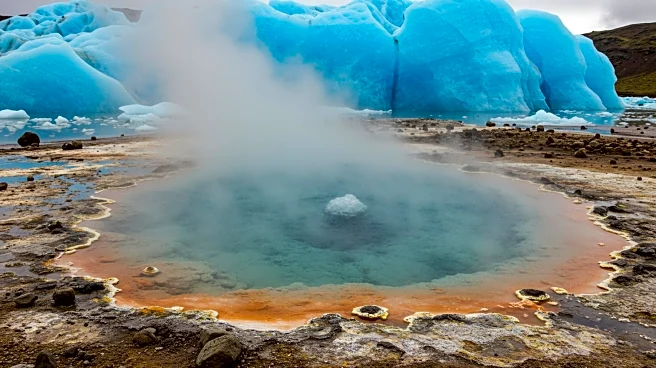What's Happening?
A new geothermal field has been discovered beneath the ice of Vatnajökull National Park in Iceland, specifically in the Esjufjöll mountains. Geologist Jón Viðar Sigurðsson identified the site while examining historical aerial imagery. The field is believed to be high-temperature, and its visibility has increased due to sustained glacier thinning. This discovery could alter the understanding of the region's geological history, as previous records from 1927 suggested a possible eruption and a major glacial flood in the area. The new evidence indicates that geothermal melting may have played a significant role in these events.
Why It's Important?
The discovery of a new geothermal field in Iceland is significant for several reasons. It could provide new insights into the geological history of the region, particularly regarding past volcanic and glacial activities. Understanding geothermal fields is crucial for assessing potential energy resources, which could impact Iceland's energy industry. Additionally, the findings may influence safety protocols and environmental monitoring in the area, as geothermal activity can affect glacier stability and contribute to glacial floods. This discovery highlights the importance of continued geological research and monitoring in regions affected by climate change.
What's Next?
Further mapping and monitoring of the newly discovered geothermal field are necessary to understand its extent and implications. Researchers will likely conduct detailed studies to assess the field's potential for energy production and its impact on the surrounding environment. The findings may prompt revisions to geological models of the region and influence future research priorities. Additionally, the discovery could lead to increased interest in exploring other areas of Vatnajökull National Park for similar geothermal activity.
Beyond the Headlines
The discovery of the geothermal field beneath Vatnajökull underscores the impact of climate change on geological research. As glaciers thin, previously hidden geological features become visible, offering new opportunities for scientific exploration. This phenomenon highlights the interconnectedness of climate change and geological processes, emphasizing the need for interdisciplinary research approaches. The findings also raise questions about the long-term effects of glacier thinning on Iceland's landscape and the potential for uncovering more hidden geological features.











